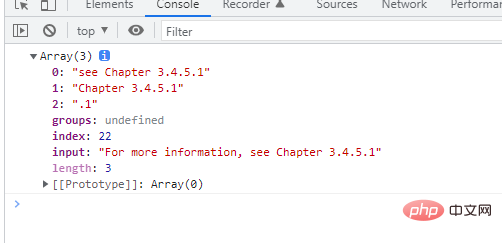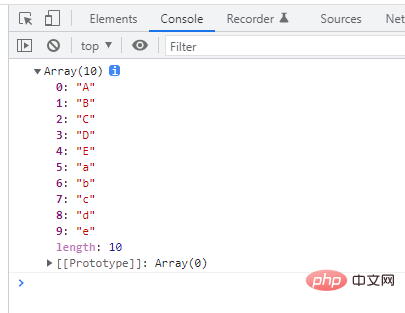es6 match() has several parameters
es6 match() only needs one parameter. The match() method is used to retrieve matches. It can search for a specified value within a string, or find a match for one or more regular expressions. The syntax is "String.match(regexp)"; this method requires only one parameter and is used to A regular expression object that specifies the pattern to match.

The operating environment of this tutorial: windows7 system, javascript version 1.8.5, Dell G3 computer.
The match() method is used to retrieve matches. You can retrieve a specified value within a string, or find a match for one or more regular expressions.
The match() method has only one parameter , syntax format:
String.match(regexp)
Parameter regexp: It is a regular expression object, a required parameter, which specifies the RegExp of the pattern to be matched. object. If the parameter is not a RegExp object, you need to first pass it to the RegExp constructor to convert it to a RegExp object.
Return value
If the g flag is used, all results matching the complete regular expression will be returned, but no capturing groups will be returned.
If the g flag is not used, only the first complete match and its associated capturing group (Array) are returned. In this case, the returned item will have additional properties as described below.
Description
The match() method will search the string string to find one or more text that matches the regexp. The behavior of this method depends heavily on whether regexp has flag g.
If regexp does not have the flag g, then the match() method can only perform one match in string. If no matching text is found, match() returns null. Otherwise, it returns an array with information about the matching text it found. The 0th element of the array holds the matching text, while the remaining elements hold the text that matches the regular expression's subexpressions. In addition to these regular array elements, the returned array contains two object properties. The index attribute declares the position of the starting character of the matching text in the string, and the input attribute declares a reference to stringObject.
If regexp has flag g, the match() method will perform a global search to find all matching substrings in string. If no matching substring is found, null is returned. If one or more matching substrings are found, an array is returned. However, the content of the array returned by global matching is very different from the former. Its array elements store all matching substrings in stringObject, and there is no index attribute or input attribute.
Note: In global search mode, match() does not provide information about the text matched by the subexpression, nor does it declare the position of each matching substring. If you need this globally retrieved information, you can use RegExp.exec().
Example 1:
Use match to find "Chapter" followed by 1 or more numeric characters, followed by a decimal point and numeric characters 0 or more times. The regular expression contains the i flag, so case is ignored.
var str = 'For more information, see Chapter 3.4.5.1'; var re = /see (chapter \d+(\.\d)*)/i; var found = str.match(re); console.log(found);

Example 2: match uses the global and ignore case flags
Demonstrates the use of match global and ignore case flags. All letters A-E, a-e will be returned as elements of an array.
var str = 'ABCDEFGHIJKLMNOPQRSTUVWXYZabcdefghijklmnopqrstuvwxyz'; var regexp = /[A-E]/gi; var matches_array = str.match(regexp); console.log(matches_array);

[Related recommendations: javascript video tutorial, web front-end】
The above is the detailed content of es6 match() has several parameters. For more information, please follow other related articles on the PHP Chinese website!

Hot AI Tools

Undresser.AI Undress
AI-powered app for creating realistic nude photos

AI Clothes Remover
Online AI tool for removing clothes from photos.

Undress AI Tool
Undress images for free

Clothoff.io
AI clothes remover

Video Face Swap
Swap faces in any video effortlessly with our completely free AI face swap tool!

Hot Article

Hot Tools

Notepad++7.3.1
Easy-to-use and free code editor

SublimeText3 Chinese version
Chinese version, very easy to use

Zend Studio 13.0.1
Powerful PHP integrated development environment

Dreamweaver CS6
Visual web development tools

SublimeText3 Mac version
God-level code editing software (SublimeText3)

Hot Topics
 Is async for es6 or es7?
Jan 29, 2023 pm 05:36 PM
Is async for es6 or es7?
Jan 29, 2023 pm 05:36 PM
async is es7. async and await are new additions to ES7 and are solutions for asynchronous operations; async/await can be said to be syntactic sugar for co modules and generator functions, solving js asynchronous code with clearer semantics. As the name suggests, async means "asynchronous". Async is used to declare that a function is asynchronous; there is a strict rule between async and await. Both cannot be separated from each other, and await can only be written in async functions.
 How to reverse an array in ES6
Oct 26, 2022 pm 06:19 PM
How to reverse an array in ES6
Oct 26, 2022 pm 06:19 PM
In ES6, you can use the reverse() method of the array object to achieve array reversal. This method is used to reverse the order of the elements in the array, putting the last element first and the first element last. The syntax "array.reverse()". The reverse() method will modify the original array. If you do not want to modify it, you need to use it with the expansion operator "...", and the syntax is "[...array].reverse()".
 Why does the mini program need to convert es6 to es5?
Nov 21, 2022 pm 06:15 PM
Why does the mini program need to convert es6 to es5?
Nov 21, 2022 pm 06:15 PM
For browser compatibility. As a new specification for JS, ES6 adds a lot of new syntax and API. However, modern browsers do not have high support for the new features of ES6, so ES6 code needs to be converted to ES5 code. In the WeChat web developer tools, babel is used by default to convert the developer's ES6 syntax code into ES5 code that is well supported by all three terminals, helping developers solve development problems caused by different environments; only in the project Just configure and check the "ES6 to ES5" option.
 How to find different items in two arrays in es6
Nov 01, 2022 pm 06:07 PM
How to find different items in two arrays in es6
Nov 01, 2022 pm 06:07 PM
Steps: 1. Convert the two arrays to set types respectively, with the syntax "newA=new Set(a);newB=new Set(b);"; 2. Use has() and filter() to find the difference set, with the syntax " new Set([...newA].filter(x =>!newB.has(x)))", the difference set elements will be included in a set collection and returned; 3. Use Array.from to convert the set into an array Type, syntax "Array.from(collection)".
 How to implement array deduplication in es5 and es6
Jan 16, 2023 pm 05:09 PM
How to implement array deduplication in es5 and es6
Jan 16, 2023 pm 05:09 PM
In es5, you can use the for statement and indexOf() function to achieve array deduplication. The syntax "for(i=0;i<array length;i++){a=newArr.indexOf(arr[i]);if(a== -1){...}}". In es6, you can use the spread operator, Array.from() and Set to remove duplication; you need to first convert the array into a Set object to remove duplication, and then use the spread operator or the Array.from() function to convert the Set object back to an array. Just group.
 What does es6 temporary Zenless Zone Zero mean?
Jan 03, 2023 pm 03:56 PM
What does es6 temporary Zenless Zone Zero mean?
Jan 03, 2023 pm 03:56 PM
In es6, the temporary dead zone is a syntax error, which refers to the let and const commands that make the block form a closed scope. Within a code block, before a variable is declared using the let/const command, the variable is unavailable and belongs to the variable's "dead zone" before the variable is declared; this is syntactically called a "temporary dead zone". ES6 stipulates that variable promotion does not occur in temporary dead zones and let and const statements, mainly to reduce runtime errors and prevent the variable from being used before it is declared, resulting in unexpected behavior.
 Is require an es6 syntax?
Oct 21, 2022 pm 04:09 PM
Is require an es6 syntax?
Oct 21, 2022 pm 04:09 PM
No, require is the modular syntax of the CommonJS specification; and the modular syntax of the es6 specification is import. require is loaded at runtime, and import is loaded at compile time; require can be written anywhere in the code, import can only be written at the top of the file and cannot be used in conditional statements or function scopes; module attributes are introduced only when require is run. Therefore, the performance is relatively low. The properties of the module introduced during import compilation have slightly higher performance.
 How to determine how many items there are in an array in es6
Jan 18, 2023 pm 07:22 PM
How to determine how many items there are in an array in es6
Jan 18, 2023 pm 07:22 PM
In ES6, you can use the length attribute of the array object to determine how many items there are in the array, that is, to get the number of elements in the array; this attribute can return the number of elements in the array, just use the "array.length" statement. Returns a value representing the number of elements of the array object, that is, the length value.






